-

新人教版高中英语选修2Unit 5 Learning about Language教学设计
The purpose of this section of vocabulary exercises is to consolidate the key words in the first part of the reading text, let the students write the words according to the English definition, and focus on the detection of the meaning and spelling of the new words. The teaching design includes use English definition to explain words, which is conducive to improving students' interest in vocabulary learning, cultivating their sense of English language and thinking in English, and making students willing to use this method to better grasp the meaning of words, expand their vocabulary, and improve their ability of vocabulary application. Besides, the design offers more context including sentences and short passage for students to practice words flexibly.1. Guide students to understand and consolidate the meaning and usage of the vocabulary in the context, 2. Guide the students to use the unit topic vocabulary in a richer context3. Let the students sort out and accumulate the accumulated vocabulary, establishes the semantic connection between the vocabulary,4. Enable students to understand and master the vocabulary more effectivelyGuiding the Ss to use unit topic words and the sentence patterns in a richer context.Step1: Read the passage about chemical burns and fill in the blanks with the correct forms of the words in the box.

新人教版高中英语选修2Unit 5 Reading and thinking教学设计
The theme of this activity is to learn the first aid knowledge of burns. Burns is common in life, but there are some misunderstandings in manual treatment. This activity provides students with correct first aid methods, so as not to take them for granted in an emergency. This section guides students to analyze the causes of scald and help students avoid such things. From the perspective of text structure and collaborative features, the text is expository. Expository, with explanation as the main way of expression, transmits knowledge and information to readers by analyzing concepts and elaborating examples. This text arranges the information in logical order, clearly presents three parts of the content through the subtitle, accurately describes the causes, types, characteristics and first aid measures of burns, and some paragraphs use topic sentences to summarize the main idea, and the level is very clear.1. Guide students to understand the causes, types, characteristics and first aid methods of burns, through reading2. Enhance students’ ability to deal withburnss and their awareness of burns prevention3. Enable students to improve the ability to judge the types of texts accurately and to master the characteristics and writing techniques of expository texts.Guide students to understand the causes, types, characteristics and first aid methods of burns, through readingStep1: Lead in by discussing the related topic:1. What first-aid techniques do you know of ?CPR; mouth to mouth artificial respiration; the Heimlich Manoeuvre

新人教版高中英语选修2Unit 5 Using langauge-Listening教学设计
The theme of this section is to learn how to make emergency calls. Students should learn how to make emergency calls not only in China, but also in foreign countries in English, so that they can be prepared for future situations outside the home.The emergency telephone number is a vital hotline, which should be the most clear, rapid and effective communication with the acute operator.This section helps students to understand the emergency calls in some countries and the precautions for making emergency calls. Through the study of this section, students can accumulate common expressions and sentence patterns in this context. 1.Help students accumulate emergency telephone numbers in different countries and learn more about first aid2.Guide the students to understand the contents and instructions of the telephone, grasp the characteristics of the emergency telephone and the requirements of the emergency telephone.3.Guide students to understand the first aid instructions of the operators.4.Enable Ss to make simulated emergency calls with their partners in the language they have learned1. Instruct students to grasp the key information and important details of the dialogue.2. Instruct students to conduct a similar talk on the relevant topic.Step1:Look and discuss:Match the pictures below to the medical emergencies, and then discuss the questions in groups.
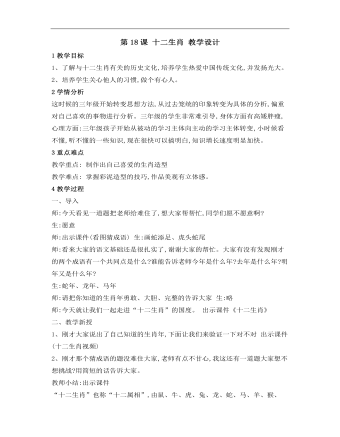
小学美术桂美版三年级上册《第18课十二生肖1》教学设计说课稿
一、导入师:今天看见一道题把老师给难住了,想大家帮帮忙,同学们愿不愿意啊?生:愿意师:出示课件(看图猜成语) 生:画蛇添足、虎头蛇尾师:看来大家的语文基础还是很扎实了,谢谢大家的帮忙。大家有没有发现刚才的两个成语有一个共同点是什么?谁能告诉老师今年是什么年?去年是什么年?明年又是什么年?生:蛇年、龙年、马年师:请把你知道的生肖年勇敢、大胆、完整的告诉大家 生:略师:今天就让我们一起走进“十二生肖”的国度。 出示课件《十二生肖》
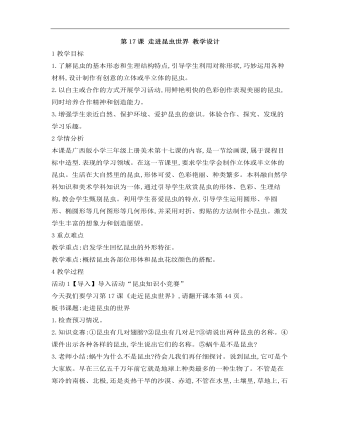
小学美术桂美版三年级上册《第17课走进昆虫世界》教学设计说课稿
2学情分析 本课是广西版小学三年级上册美术第十七课的内容,是一节绘画课,属于课程目标中造型.表现的学习领域。在这一节课里,要求学生学会制作立体或半立体的昆虫。生活在大自然里的昆虫,形体可爱、色彩艳丽、种类繁多。本科融自然学科知识和美术学科知识为一体,通过引导学生欣赏昆虫的形体、色彩、生理结构,教会学生甄别昆虫。利用学生喜爱昆虫的特点,引导学生运用圆形、半圆形、椭圆形等几何图形等几何形体,并采用对折、剪贴的方法制作小昆虫。激发学生丰富的想象力和创造愿望。
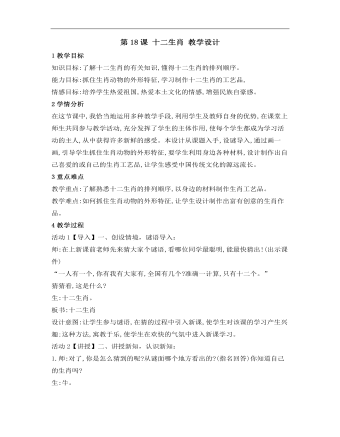
小学美术桂美版三年级上册《第18课十二生肖2》教学设计说课稿
2学情分析在这节课中,我恰当地运用多种教学手段,利用学生及教师自身的优势,在课堂上师生共同参与教学活动,充分发挥了学生的主体作用,使每个学生都成为学习活动的主人,从中获得许多新鲜的感受。本设计从课题入手,设谜导入,通过画一画,引导学生抓住生肖动物的外形特征,要学生利用身边各种材料,设计制作出自己喜爱的或自己的生肖工艺品,让学生感受中国传统文化的源远流长。
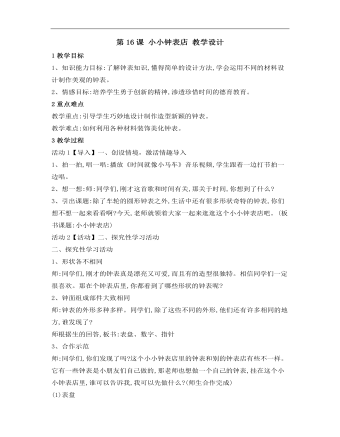
小学美术桂美版三年级上册《第16课小小钟表店1》教学设计说课稿
3教学过程活动1【导入】一、创设情境,激活情趣导入 1、拍一拍,唱一唱:播放《时间就像小马车》音乐视频,学生跟着一边打节拍一边唱。2、想一想:师:同学们,刚才这首歌和时间有关,那关于时间,你想到了什么?3、引出课题:除了车轮的圆形钟表之外,生活中还有很多形状奇特的钟表,你们想不想一起来看看啊?今天,老师就领着大家一起来逛逛这个小小钟表店吧。(板书课题:小小钟表店)
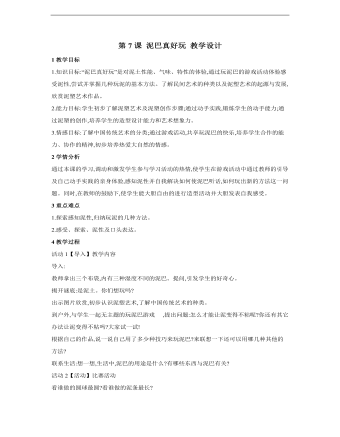
小学美术桂美版一年级上册《第7课泥巴真好玩》教学设计说课稿
2学情分析 通过本课的学习,调动和激发学生参与学习活动的热情,使学生在游戏活动中通过教师的引导及自己动手实践的亲身体验,感知泥性并自我解决如何使泥巴听话,如何玩出新的方法这一问题。同时,在教师的鼓励下,使学生能大胆自由的进行造型活动并大胆发表自我感受。3重点难点 1.探索感知泥性,归纳玩泥的几种方法。2.感受、探索、泥性及口头表达。
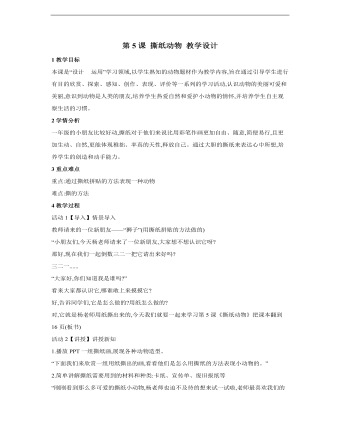
小学美术桂美版一年级上册《第5课撕纸动物》教学设计说课稿
2学情分析 一年级的小朋友比较好动,撕纸对于他们来说比用彩笔作画更加自由、随意,简便易行,且更加生动、自然,更能体现稚拙、率真的天性,释放自己。通过大胆的撕纸来表达心中所想,培养学生的创造和动手能力。3重点难点 重点:通过撕纸拼贴的方法表现一种动物难点:撕的方法
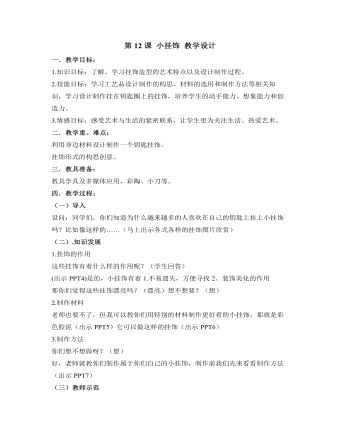
小学美术桂美版三年级上册《第12课小挂饰3》教学设计说课稿
二.教学重、难点:利用身边材料设计制作一个钥匙挂饰。挂饰形式的构思创意。三.教具准备:教具学具及多媒体应用,彩陶、小刀等。四.教学过程:(一)导入设问:同学们,你们知道为什么越来越多的人喜欢在自己的钥匙上挂上小挂饰吗?比如像这样的……(马上出示各式各样的挂饰图片欣赏)
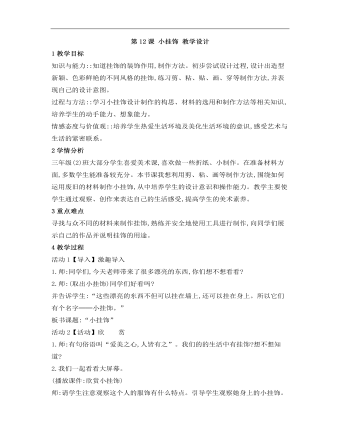
小学美术桂美版三年级上册《第12课小挂饰1》教学设计说课稿
2学情分析三年级(2)班大部分学生喜爱美术课,喜欢做一些折纸、小制作。在准备材料方面,多数学生能准备较充分。本节课我想利用剪、粘、画等制作方法,围绕如何运用废旧的材料制作小挂饰,从中培养学生的设计意识和操作能力。教学主要使学生通过观察、创作来表达自己的生活感受,提高学生的美术素养。3重点难点寻找与众不同的材料来制作挂饰,熟练并安全地使用工具进行制作,向同学们展示自己的作品并说明挂饰的用途。
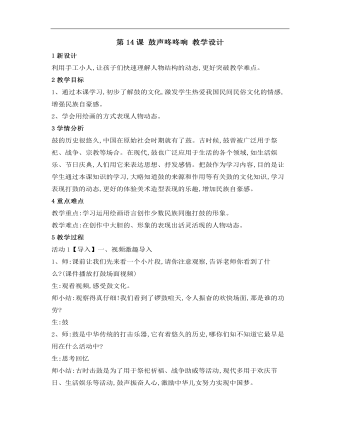
小学美术桂美版三年级上册《第14课鼓声咚咚响3》教学设计说课稿
3学情分析 鼓的历史很悠久,中国在原始社会时期就有了鼓。古时候,鼓曾被广泛用于祭祀、战争、宗教等场合。在现代,鼓也广泛应用于生活的各个领域,如生活娱乐、节日庆典,人们用它来表达思想、抒发感情。把鼓作为学习内容,目的是让学生通过本课知识的学习,大略知道鼓的来源和作用等有关鼓的文化知识,学习表现打鼓的动态,更好的体验美术造型表现的乐趣,增加民族自豪感。4重点难点 教学重点:学习运用绘画语言创作少数民族同胞打鼓的形象。教学难点:在创作中大胆的、形象的表现出活灵活现的人物动态。
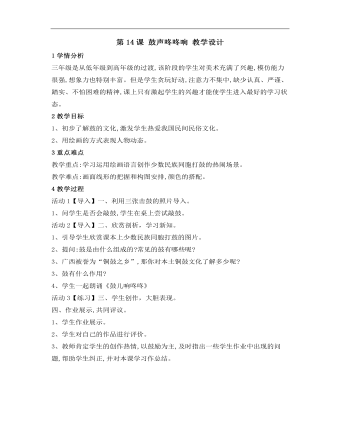
小学美术桂美版三年级上册《第14课鼓声咚咚响1》教学设计说课稿
2教学目标1、初步了解鼓的文化,激发学生热爱我国民间民俗文化。2、用绘画的方式表现人物动态。3重点难点教学重点:学习运用绘画语言创作少数民族同胞打鼓的热闹场景。教学难点:画面线形的把握和构图安排,颜色的搭配。
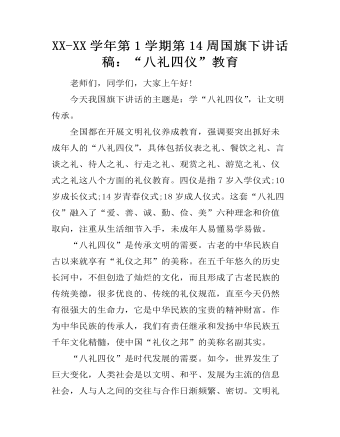
XX-XX学年第1学期第14周国旗下讲话稿:“八礼四仪”教育
老师们,同学们,大家上午好!今天我国旗下讲话的主题是:学“八礼四仪”,让文明传承。全国都在开展文明礼仪养成教育,强调要突出抓好未成年人的“八礼四仪”,具体包括仪表之礼、餐饮之礼、言谈之礼、待人之礼、行走之礼、观赏之礼、游览之礼、仪式之礼这八个方面的礼仪教育。四仪是指7岁入学仪式;10岁成长仪式;14岁青春仪式;18岁成人仪式。这套“八礼四仪”融入了“爱、善、诚、勤、俭、美”六种理念和价值取向,注重从生活细节入手,未成年人易懂易学易做。“八礼四仪”是传承文明的需要。古老的中华民族自古以来就享有“礼仪之邦”的美称。在五千年悠久的历史长河中,不但创造了灿烂的文化,而且形成了古老民族的传统美德,很多优良的、传统的礼仪规范,直至今天仍然有很强大的生命力,它是中华民族的宝贵的精神财富。
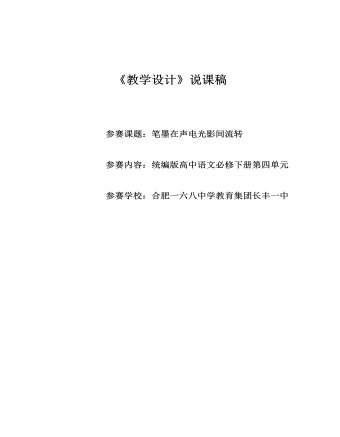
第四单元《教学设计》 说课稿 2021—2022学年统编版高中语文必修下册
(六)说教学策略1.专题性海量的媒介信息必须加以选择或者整合,以项目为依据,进行信息筛选,形成专题性阅读与交流;培养学生对文本信息“化零为整”的能力,提升跨媒介阅读与交流学习的充实感。2.情境化情境教学应指向学生的应用,建构富有符合时代气息的内容,与生活经验更加贴合,对学生的语言建构与运用有所提升,在情境中能够有效地进行交流。3.任务化以任务为导向的序列化学习,可以为学生构建学习路线图、学习框架等具体任务引导;或以跨媒介的认识与应用为任务的设置引导;甚至以阅读和交流作为序列化安排的实践引导。4.整合性跨媒介阅读与交流是结合线上线下的资源,形成新的“超媒介”,也能实现对信息进行“深加工”,多种媒介的信息整合只为一个核心教学内容服务。5.互文性语言文字是语文之生命,我们是立足于语言文字的探讨,音乐、图像、视频等文本与传统语言文字文本形成互文,触发学生对学习内容立体化和具体化的感悟,提升学生的审美能力。

人音版小学音乐一年级上法国号口风琴教学说课稿
6、学生展示此环节教学时我借助演唱和口风琴伴奏、口风琴与舞蹈律动、口风琴与打击乐合奏等形式,给时间学生自由组合,让同学们分组合作展示。力求同学之间互帮互助、相互启发,以此增进学生的团队合作精神。7、课堂小结小结时我鼓励学生开展互评、自评等方式,从而让学生正视自己,尊重他人。七、课后反思“兴趣是最好的老师”,此节音乐课的设计我觉得充满了乐趣,教学时处处呈现师生合作,生生合作的愉快场景。“大风与小风”的游戏成了本节课的亮点,它让学生在自主参与音乐实践中体会到音乐的无限魅力。但不足的是实际操作过程中由于时间的关系曲子弹得不够扎实,个别学生弹得不够熟练。以上设计如有不足之处,敬请各位专家、同仁提出宝贵意见。谢谢!

幼儿园小班健康安全活动教案:夏季防溺水安全教案
一、创设情境,谈话导入。 1、谈话:炎热的夏天悄悄来到了,你最喜欢参加夏天的什么活动? 2、创设情境,激发幼儿的兴趣。播放海滩的游泳景象的录像,激发幼儿参加的热情,创设一起外出去游泳的情境。 二、引导自主选择、辨析,学会饮食卫生。 1、创设情境:在途中大家口渴难忍,要购买水果、饮料。 2、出示水果,幼儿自主选择、辨析。
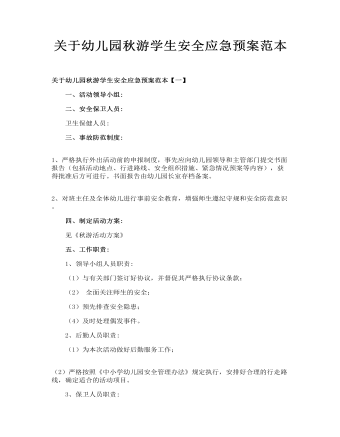
关于幼儿园秋游学生安全应急预案范本
1、牢固树立“安全第一,预防为主”的思想。活动前各班对幼儿进行专题安全教育,特别注意交通安全、饮食卫生、游戏安全等容易引发事故环节的安全教育,增强幼儿的安全意识和自我保护能力。 2、活动必须保持高度统一性,活动全过程(活动线路、集合、返幼儿园时间、安全规定等)服从活动领导小组的统一指挥。学幼儿园指派行政领导全程参与年级指导,班主任与配班教师共同做好本班组织管理工作。
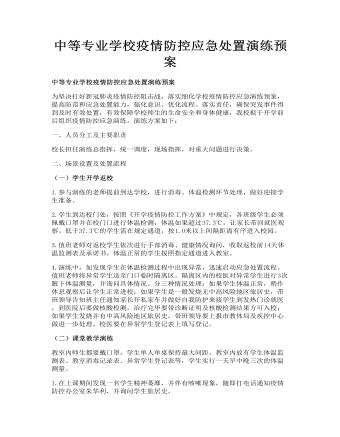
中等专业学校疫情防控应急处置演练预案
1.参与演练的老师提前到达学校,进行消毒、体温检测环节处理,做好迎接学生准备。2.学生到达校门处,按照《开学疫情防控工作方案》中规定,各班级学生必须佩戴口罩并在校门口进行体温检测,体温如果超过37.3℃,让家长带回就医观察。低于37.3℃的学生需在规定通道,按1.0米以上间隔距离有序进入校园。3.值班老师对返校学生依次进行手部消毒、健康情况询问,收取返校前14天体温监测表及承诺书。体温正常的学生按照指定通道进入教室。
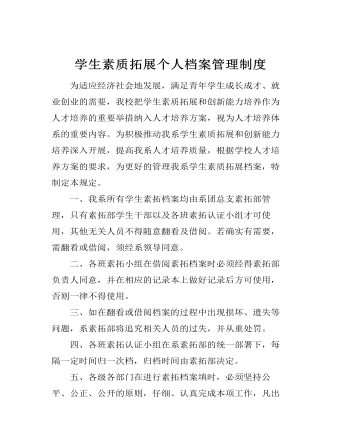
学生素质拓展个人档案管理制度
一、我系所有学生素拓档案均由系团总支素拓部管理,只有素拓部学生干部以及各班素拓认证小组才可使用,其他无关人员不得随意翻看及借阅。若确实有需要,需翻看或借阅,须经系领导同意。 二、各班素拓小组在借阅素拓档案时必须经得素拓部负责人同意,并在相应的记录本上做好记录后方可使用,否则一律不得使用。

